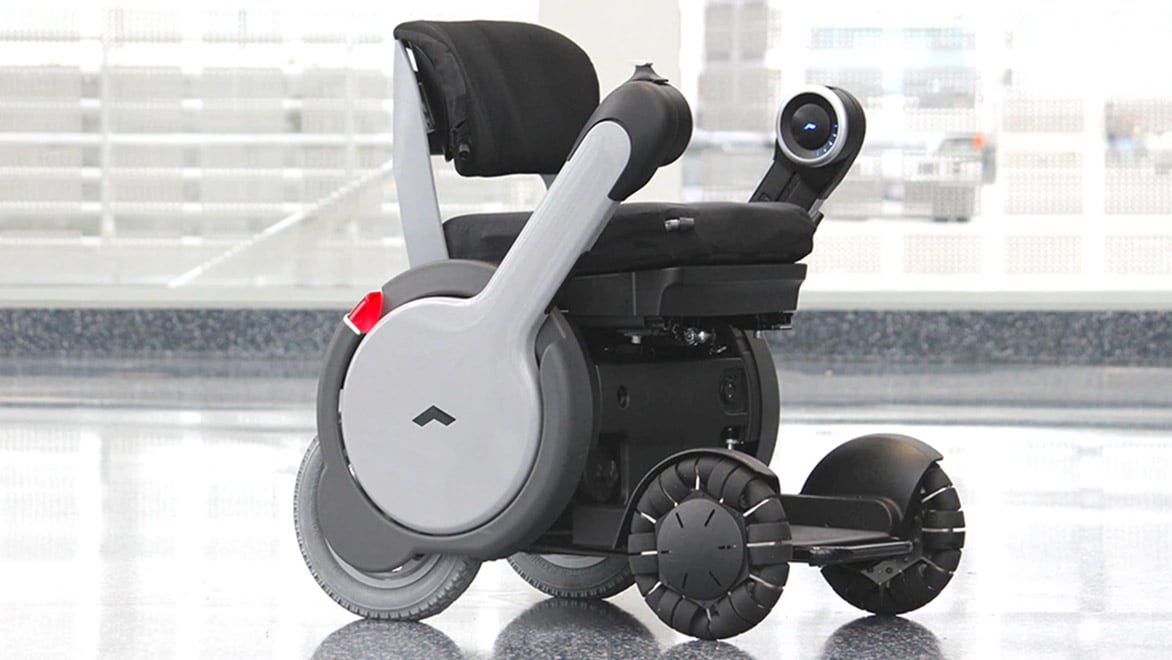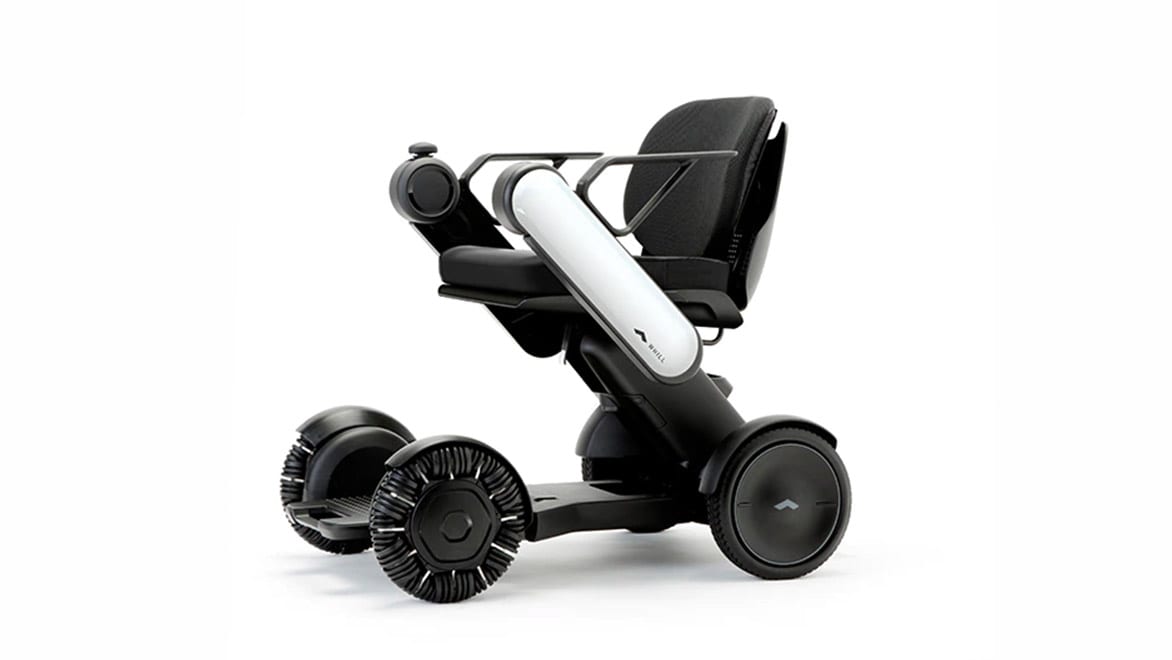WHILL
Shaping the next generation of personal mobility with generative design
THE FUTURE OF MAKING
Share this story
Personal electric-vehicle manufacturer uses technology to give people with mobility impairments more freedom
WHILL is designing the next generation of personal mobility devices to help wheelchair users rise above the limitations of conventional power wheelchairs and scooters. With the goal of pushing the boundaries of personal transportation for anyone, regardless of disability or age, the company developed the award-winning portable Model C device. WHILL is exploring the newest technologies to develop even smarter designs, lightweighting mobility devices with generative design to empower users with even greater mobility and style.
Using technology to solve a social problem
Co-founded in 2011 by three engineers in Japan, WHILL designs and manufactures personal electric vehicles (EVs). The inspiration that launched WHILL was a friend of the group’s—a wheelchair user. He was active and social, but in his wheelchair, he felt people saw him as “a guy who has a disability and needs help.” He stopped going outside and taking part in activities he enjoyed. “I’ve even given up on going to the grocery store just two blocks away,” he said.
Traditional wheelchair design favors functionality over individuality, so the WHILL engineers set out to create a mobility device that would empower their friend and help him move about in the world with confidence and enthusiasm.

Yoshihiro Hirata (right), head of Vehicle development group at WHILL, models lightweight frame designs with generative-design software.
“At WHILL, we want to overcome two different barriers with our work,” says Yoshihiro Hirata, head of WHILL’s Vehicle development group. “The first barrier is physical, and the second barrier is mental. Physical barriers include uneven surfaces and unpaved pathways that are difficult for conventional wheelchairs to navigate. Many cities and towns in Japan haven’t yet become truly barrier-free, and it makes it difficult for wheelchair users to go out.
“And the mental barriers come from encountering people who are afraid or hesitant to approach wheelchair users,” he continues. “These two issues often end up discouraging mobility-impaired people from leaving their homes. We think the innovative design and smart functionality of WHILL’s personal mobility devices can help break down those barriers.”
Today, WHILL has facilities in Japan, California, and Amsterdam, with the Yokohama office focusing on product development from concept through manufactured product. Using Fusion 360, the product team can work together in a collaborative workflow, documenting and sharing information via the cloud.
A more portable EV, built with mobility in mind
WHILL’s first personal EV, the Model A, was popular and well-received upon its debut in 2014. However, the company received customer feedback such as, “I wish it was lighter,” “I want to be able to stow it in my car easily,” and “I want a more affordable model.” Based on this input, WHILL created the Model C, which debuted in Japan in April 2017. It’s half the weight of the Model A and easily disassembles into three separate modules.
“Our research showed that for the average person to lift and load something into a car’s trunk, it shouldn’t be more than 15 to 20 kilograms [33 to 44 pounds],” Hirata says. “It wasn’t feasible to make a collapsible device in that weight range, so in our concept, the battery is removable, and the body breaks down into pieces.”

The Model C received awards such as the iF Design Award, the Red Dot Design Award, and the Good Design Award. Courtesy of WHILL.
“Our challenge was to see how much of the frame we could pare away while leaving the drive mechanism intact,” Hirata says. The weight of each individual part of the Model C was reduced to 14.5 kilograms each for the seat and the piece with the front wheels and bottom panel, and 20 kilograms for the main body containing the heavy drive mechanism and the motor. This makes it possible for a person to load the parts into the trunk of a typical sedan and reassemble it at the destination. The cost of the Model C is also less than half that of the Model A.
The Model C made its United States debut (as the Model Ci) at the Consumer Electronics Show (CES) in Las Vegas in 2018, and the device has won multiple technology awards, including CES Best of Innovation awards in 2018. It was also named by Time magazine as one of the 50 Best Inventions of 2018.

Metal lace clutch design in AutoCAD LT. Courtesy of Wendy Stevens.
Generative design provides the optimal frame configuration
Looking at the future of the Model C, Hirata and the chassis-development group’s long-term vision is to reduce the weight of the EV as much as possible. To achieve a lighter body design, he and his team tried out the generative-design technology in Fusion 360. He first considered using topology optimization, a mathematical method for optimizing the frame, “but it became apparent it had some technical limitations,” Hirata says. “We thought that using generative design—where we would start with a blank slate and build optimal shapes from there—could give us the results we were looking for.”
Generative design provides designers and engineers with design alternatives based on design goals and constraints. The software explores all the possible permutations of a solution, quickly generating dozens of options to choose from.

WHILL’s first personal EV, the Model A, debuted in 2014. Courtesy of WHILL.
Despite it being his first project using generative design in Fusion 360, Hirata was able to realize a lightweight design that exceeded his expectations. “I think our design embodies the essence of generative design,” he says. “We were able to lighten the frame alone by more than 30%. While we knew that the shapes of the part would be difficult to fabricate using mass-production techniques, we went forward with them to see how far we could go in applying the mathematical results of the generative-design process.”
The WHILL team had to consider what materials to use to ensure they’re strong, lightweight, and cost-effective enough to meet the customer requirements, as well as the loads on the part in all phases of operation and manufacturing and assembly constraints. “We made a list of the tests we’d do and then created a lineup of designs using shapes we thought would perform well,” Hirata says. He left it up to his team to input the modeling and weight constraints.

The generatively designed frame for the Model C reduces the weight by more than 30%.
A glimpse into the future of product design
Hirata has shared the results of his experiments using generative design with his colleagues. “The teams working on software and electrical components have been following our progress,” he says. “We all feel as if we’re getting a glimpse into the future with this technology. I’m starting to research how we can translate it into mass production and how this approach can be incorporated into a mass-produced design down the road. I’d like to find a way to use this technology throughout our company.”
Hirata believes this kind of technology could serve as the basis for new design methods. “Looking back at the history of product design, it seems to me that trends often arise alongside the emergence of new design tools,” he says. “Before 3D CAD was used, designs were flat and planar, but now smoother, curved lines are used more often. Soon, I think the design world will show the influence of generative design.”
He also sees generative design in Fusion 360 as an essential tool for making more efficient, attractive product designs. “The tools we use aren’t just for engineers—we also need them to design cool products,” Hirata continues. “The strength of generative design lies in its power to translate drawings and ideas into their pure essence in an incredibly intuitive way.”

The company is exploring ways to translate the generatively designed frame into traditional mass-production techniques.



